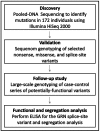Pooled-DNA sequencing identifies novel causative variants in PSEN1, GRN and MAPT in a clinical early-onset and familial Alzheimer's disease Ibero-American cohort
- PMID: 22906081
- PMCID: PMC3506948
- DOI: 10.1186/alzrt137
Pooled-DNA sequencing identifies novel causative variants in PSEN1, GRN and MAPT in a clinical early-onset and familial Alzheimer's disease Ibero-American cohort
Abstract
Introduction: Some familial Alzheimer's disease (AD) cases are caused by rare and highly-penetrant mutations in APP, PSEN1, and PSEN2. Mutations in GRN and MAPT, two genes associated with frontotemporal dementia (FTD), have been found in clinically diagnosed AD cases. Due to the dramatic developments in next-generation sequencing (NGS), high-throughput sequencing of targeted genomic regions of the human genome in many individuals in a single run is now cheap and feasible. Recent findings favor the rare variant-common disease hypothesis by which the combination effects of rare variants could explain a large proportion of the heritability. We utilized NGS to identify rare and pathogenic variants in APP, PSEN1, PSEN2, GRN, and MAPT in an Ibero-American cohort.
Methods: We performed pooled-DNA sequencing of each exon and flanking sequences in APP, PSEN1, PSEN2, MAPT and GRN in 167 clinical and 5 autopsy-confirmed AD cases (15 familial early-onset, 136 sporadic early-onset and 16 familial late-onset) from Spain and Uruguay using NGS. Follow-up genotyping was used to validate variants. After genotyping additional controls, we performed segregation and functional analyses to determine the pathogenicity of validated variants.
Results: We identified a novel G to T transition (g.38816G>T) in exon 6 of PSEN1 in a sporadic early-onset AD case, resulting in a previously described pathogenic p.L173F mutation. A pathogenic p.L392V mutation in exon 11 was found in one familial early-onset AD case. We also identified a novel CC insertion (g.10974_10975insCC) in exon 8 of GRN, which introduced a premature stop codon, resulting in nonsense-mediated mRNA decay. This GRN mutation was associated with lower GRN plasma levels, as previously reported for other GRN pathogenic mutations. We found two variants in MAPT (p.A152T, p.S318L) present only in three AD cases but not controls, suggesting that these variants could be risk factors for the disease.
Conclusions: We found pathogenic mutations in PSEN1, GRN and MAPT in 2.33% of the screened cases. This study suggests that pathogenic mutations or risk variants in MAPT and in GRN are as frequent in clinical AD cases as mutations in APP, PSEN1 and PSEN2, highlighting that pleiotropy of MAPT or GRN mutations can influence both FTD and AD phenotypic traits.
Figures



References
-
- 2009 Alzheimer's disease facts and figures. Alzheimers Dement. 2009;5:234–270. - PubMed
-
- Goate A, Chartier-Harlin M-C, Mullan M, Brown J, Crawford F, Fidani L, Giuffra L, Haynes A, Irving N, James L, Mant R, Newton P, Rooke K, Roques P, Talbot C, Pericak-Vance M, Roses A, Williamson R, Rossor M, Owen M, Hardy J. Segregation of a missense mutation in the amyloid precursor protein gene with familial Alzheimer's disease. Nature. 1991;349:704–706. doi: 10.1038/349704a0. - DOI - PubMed
-
- Sherrington R, Rogaev EI, Liang Y, Rogaeva EA, Levesque G, Ikeda M, Chi H, Lin C, Li G, Holman K, Tsuda T, Mar L, Foncin JF, Bruni AC, Montesi MP, Sorbi S, Rainero I, Pinessi L, Nee L, Chumakov I, Pollen D, Brookes A, Sanseau P, Polinsky RJ, Wasco W, Da Silva HA, Haines JL, Perkicak-Vance MA, Tanzi RE, Roses AD. et al.Cloning of a gene bearing missense mutations in early-onset familial Alzheimer's disease. Nature. 1995;375:754–760. doi: 10.1038/375754a0. - DOI - PubMed
-
- Rogaev EI, Sherrington R, Rogaeva EA, Levesque G, Ikeda M, Liang Y, Chi H, Lin C, Holman K, Tsuda T, Mar L, Sorbi S, Nacmias B, Piacentini S, Amaducci L, Chumakov I, Cohen D, Lannfelt L, Fraser PE, Rommens JM, St George-Hyslop PH. Familial Alzheimer's disease in kindreds with missense mutations in a gene on chromosome 1 related to the Alzheimer's disease type 3 gene. Nature. 1995;376:775–778. doi: 10.1038/376775a0. - DOI - PubMed
Grants and funding
LinkOut - more resources
Full Text Sources
Other Literature Sources
Miscellaneous

